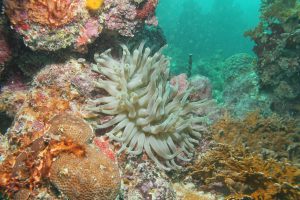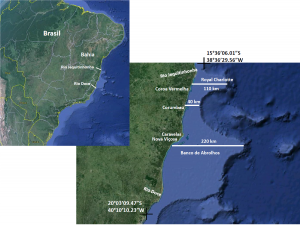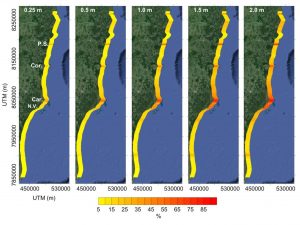10 November 2017
Rising sea levels could weaken coral reefs’ protective influence on Brazil’s coast
Posted by Joseph Cariz
By Joseph Cariz

The Albrolhos region in northeast Brazil is home to the largest coral reef system in the South Atlantic.
Image credit: Dilson Cajueiro Filho
Rising sea levels could diminish the ability of Brazil’s coral reef systems to weaken incoming ocean waves, resulting in stronger waves hitting populated areas on the Brazilian coastline, according to new research published in Earth’s Future, a journal of the American Geophysical Union.
The new study examined the effects of sea level rise on the energy of waves reaching the coastline of northeast Brazil, home to many famous beaches and the largest coral reef system in the South Atlantic. These reefs buffer waves hitting the coast and protect the shore from erosion. The study’s authors found higher sea levels means waves hitting the coastline will pass further above the coral reefs than they do now, reducing the reefs’ protective influence.
As a result, these waves will reach the coast with up to a 90 percent increase in power and will accelerate erosion of the coastline, according to the new study. The new results support previous studies that have found sea level rise will boost wave power, negatively impacting coral reef ecosystems and populated coastal areas.
The study’s findings have implications for urban development on tropical coastlines and the management of coastal coral reefs, according to Eduardo Siegle, an oceanographer at the Oceanographic Institute of the University of São Paulo in Brazil and lead author of the new study. Coral reefs are already threatened by human activities such as overfishing and pollution, and sea level rise could exacerbate the situation.
“As a result of sea level rise waves will reach the coast with more power, and consequently we’ll see increased sediment transport and coastal erosion in these areas,” Siegle said. “This will be a problem in tropical coastal regions that are shaped by the protection of reefs and are now urbanized areas with large populations.”
Protecting coastlines
Coral reefs play an important role in the development of coastal structures and ecosystems because they partially shield the coast from incoming ocean waves. When a wave passes over a reef system, the reef’s structure saps energy from the wave and greatly diminishes its power. Coastal areas behind these protective reefs are known as “shadow zones,” and undergo less coastline erosion compared to unprotected areas.

The study examined a large stretch of the Brazilian coastline between the Doce and Jequitinhonha rivers.
Image credit: Eduardo Siegle/Google Earth.
This mechanism plays a key role in the shaping of densely populated coastal regions. A recent study found coral reefs reduce wave energy by as much as 97 percent, on average, and an estimated 197 million people live in areas protected by reefs worldwide.
However, a rise in sea levels could weaken the protective influence of coral reefs by increasing the distance between the reefs and waves passing overhead. A previous study examined the effects of sea level rise on fringing reefs—one of the main types of coral reefs—in Hawaii and concluded a sea level rise of up to one meter (three feet) could significantly increase wave power and threaten the existing reef ecosystem.
The new study examines the effects of sea level rise on chapeirões, another type of reef system. Chapeirões feature mushroom-shaped reef structures and are unique to the Brazilian coastline. They make up a significant portion of the reef structure in the Abrolhos region, a coastal area in the northeast of Brazil which hosts the largest coral reef system in the South Atlantic and is home to some of the country’s famous beaches.
Sea-level rise and wave power
Siegle’s team modeled the effects of several sea level rise scenarios along a 450 kilometer (280 mile) stretch of coastline in the northeast of Brazil. Scientists expect sea levels will increase by at least .2 meters (8 inches) but not more than 2 meters (6.5 feet) by 2100.
The researchers modeled sea level increases ranging from .25 meters to 2 meters (1 foot to 6.5 feet), and studied their effects on the height and frequency of waves reaching the coast. They then calculated how changes in these variables would influence the waves’ strength.
The study found the power of incoming waves in the region would increase in proportion to the magnitude of sea level rise. The authors calculated a .25 meter (1 foot) rise in sea levels would result in a 30 percent increase in wave power, while a larger increase of 2 meters (6.5 feet) would lead to an 80 to 90 percent increase in wave power.

A figure showing how different sea level rise scenarios will increase the power of waves reaching the Brazilian coast near the Albrolhos region. Areas of the coastline shaded in red will experience higher percentage increases in wave power compared to areas shaded in yellow.
Image credit: Siegle et al.
The findings suggest significant portions of the Brazilian coastline could see drastic changes in coastal structures, according to Siegle. Habitable areas of the coastline could be pushed inland by increased coastal erosion, and existing developed areas could be negatively affected, he said.
Additionally, coral reefs around the world already face stress from bleaching events, pollution from agriculture and invasive species. As time progresses, these factors could lead to the reduction of coral reefs and further increase wave power, Siegle said.
Rising sea levels could also have negative consequences for the coral reefs themselves. An increase in wave power would kick up higher amounts of sediment from the slopes of coral reefs and the shoreline. The resulting increase in water turbidity could damage coral reef ecosystems, according to Siegle.










 GeoSpace is a blog on Earth and space science, managed by AGU’s Public Information staff. The blog features posts by AGU writers and guest contributors on all sorts of relevant science topics, but with a focus on new research and geo and space sciences-related stories that are currently in the news.
GeoSpace is a blog on Earth and space science, managed by AGU’s Public Information staff. The blog features posts by AGU writers and guest contributors on all sorts of relevant science topics, but with a focus on new research and geo and space sciences-related stories that are currently in the news.